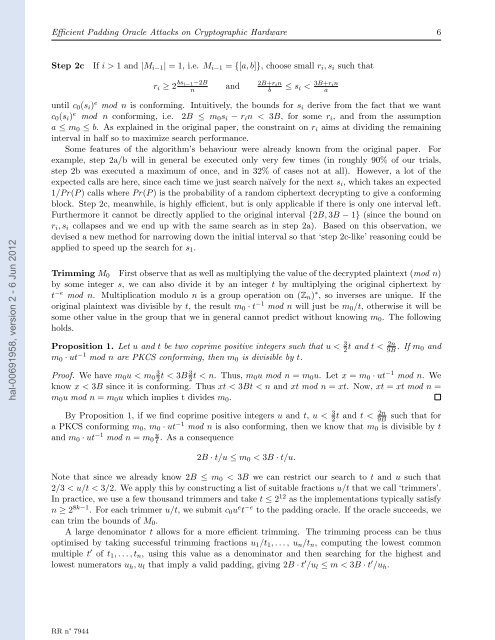RR-7944
RR-7944
RR-7944
Create successful ePaper yourself
Turn your PDF publications into a flip-book with our unique Google optimized e-Paper software.
hal-00691958, version 2 - 6 Jun 2012<br />
Efficient Padding Oracle Attacks on Cryptographic Hardware 6<br />
Step 2c If i > 1 and |Mi−1| = 1, i.e. Mi−1 = {[a, b]}, choose small ri, si such that<br />
ri ≥ 2 bsi−1−2B<br />
n<br />
and<br />
2B+rin<br />
b<br />
≤ si < 3B+rin<br />
a<br />
until c0(si) e mod n is conforming. Intuitively, the bounds for si derive from the fact that we want<br />
c0(si) e mod n conforming, i.e. 2B ≤ m0si − rin < 3B, for some ri, and from the assumption<br />
a ≤ m0 ≤ b. As explained in the original paper, the constraint on ri aims at dividing the remaining<br />
interval in half so to maximize search performance.<br />
Some features of the algorithm’s behaviour were already known from the original paper. For<br />
example, step 2a/b will in general be executed only very few times (in roughly 90% of our trials,<br />
step 2b was executed a maximum of once, and in 32% of cases not at all). However, a lot of the<br />
expected calls are here, since each time we just search naïvely for the next si, which takes an expected<br />
1/Pr(P ) calls where Pr(P ) is the probability of a random ciphertext decrypting to give a conforming<br />
block. Step 2c, meanwhile, is highly efficient, but is only applicable if there is only one interval left.<br />
Furthermore it cannot be directly applied to the original interval {2B, 3B − 1} (since the bound on<br />
ri, si collapses and we end up with the same search as in step 2a). Based on this observation, we<br />
devised a new method for narrowing down the initial interval so that ‘step 2c-like’ reasoning could be<br />
applied to speed up the search for s1.<br />
Trimming M0 First observe that as well as multiplying the value of the decrypted plaintext (mod n)<br />
by some integer s, we can also divide it by an integer t by multiplying the original ciphertext by<br />
t −e mod n. Multiplication modulo n is a group operation on (Zn) ∗ , so inverses are unique. If the<br />
original plaintext was divisible by t, the result m0 · t −1 mod n will just be m0/t, otherwise it will be<br />
some other value in the group that we in general cannot predict without knowing m0. The following<br />
holds.<br />
Proposition 1. Let u and t be two coprime positive integers such that u < 3<br />
m0 · ut −1 mod n are PKCS conforming, then m0 is divisible by t.<br />
Proof. We have m0u < m0 3<br />
2<br />
2<br />
t and t < 2n<br />
9B . If m0 and<br />
t < 3B 3<br />
2 t < n. Thus, m0u mod n = m0u. Let x = m0 · ut −1 mod n. We<br />
know x < 3B since it is conforming. Thus xt < 3Bt < n and xt mod n = xt. Now, xt = xt mod n =<br />
m0u mod n = m0u which implies t divides m0.<br />
By Proposition 1, if we find coprime positive integers u and t, u < 3<br />
2n<br />
2t and t < 9B such that for<br />
a PKCS conforming m0, m0 · ut−1 mod n is also conforming, then we know that m0 is divisible by t<br />
. As a consequence<br />
and m0 · ut −1 mod n = m0 u<br />
t<br />
2B · t/u ≤ m0 < 3B · t/u.<br />
Note that since we already know 2B ≤ m0 < 3B we can restrict our search to t and u such that<br />
2/3 < u/t < 3/2. We apply this by constructing a list of suitable fractions u/t that we call ‘trimmers’.<br />
In practice, we use a few thousand trimmers and take t ≤ 2 12 as the implementations typically satisfy<br />
n ≥ 2 8k−1 . For each trimmer u/t, we submit c0u e t −e to the padding oracle. If the oracle succeeds, we<br />
can trim the bounds of M0.<br />
A large denominator t allows for a more efficient trimming. The trimming process can be thus<br />
optimised by taking successful trimming fractions u1/t1, . . . , un/tn, computing the lowest common<br />
multiple t ′ of t1, . . . , tn, using this value as a denominator and then searching for the highest and<br />
lowest numerators uh, ul that imply a valid padding, giving 2B · t ′ /ul ≤ m < 3B · t ′ /uh.<br />
<strong>RR</strong> n° <strong>7944</strong>


